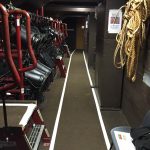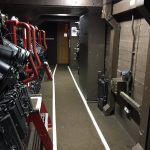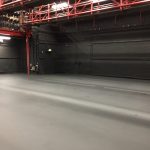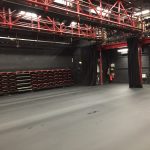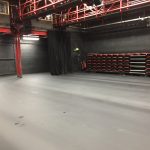By the time we reached CPP1/4 we’d found our way of working, both with each other and with the groups that came through the space. I’d also learnt that, in order to make the process go by easier, I should prepare to take on the HOD role at any moment, due to my TSM’s continued ability to disappear from the venue for long periods of time. The first of these groups brought our venue back to how we were used to having it, our seating bank coming back out and another sacrificial floor going down. This time, we had taken elements of the Opera set to create a stately home, with the lower section of the Fledermaus staircase joining us as well, installed along the back wall. What was different about these shows, however, was the turnaround time we had been given. Between each of these performances was only a morning session to install the appropriate scenic elements, an afternoon session to focus and pre-plot and an evening session to tech with cast. Had this been at the beginning of the CPP run, someone would definitely have ended up crying on the floor – and yes, it likely would have been me. However, at the point we were at, we needed a challenge to keep us working effectively, and I felt that this fast a turnaround was exactly what we needed to keep spirits and momentum high.
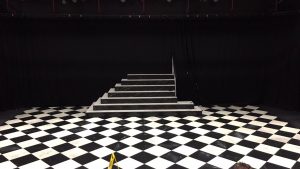
When Opera Needs to be About 12m Shorter
The only other element of the first group was a chandelier that we had borrowed from the Citizens Theatre – with the job of hanging it falling to me. In an effort to prove I knew what I was doing, and to practice something I had been shown on Opera, I decided to open basket rig from the ground, my equipment taking the form of a couple of one tonne shackles and a two metre strop which would be lashed round the bar and secured onto itself. We then strung a line to the chandelier which I tied with a figure of eight onto a further shackle to ensure that, no matter how much pressure was applied, it was in no danger of falling. Like all of my other rig plans, Malcy listened as I explained what I wanted to do and, with some minor alterations of shackle positions, we flew the beast with James in the air to affix it to its final point. We then took the tied on line up onto the catwalks and left it coiled, so as to make our strike easier as our point was already on our fixture. It was nice to have been given a challenge like this again, and be put in a position to think on my feet. Whereas earlier this seemed an undue burden, I now felt in a position where I could speak with self belief, which was a refreshing change.
After the first group had finished their performance, we set about turning the venue into a traverse space – striking everything to turn it into a black box with only steel deck risers and a piano to give it character. As the LX rig was the main focus of this show, I joined their team, working from the air with my knowledge of rope work to safely raise and lower their boom poles and Solar Spot fixtures, before jumping to the ground to help with a plug up. This cross discipline kind of work was the only way this turnaround could have been done in the time and – for future – I feel it is very important that this should be stressed by all parties and HODs as the primary method of working and crewing festival style allocations like this. As an added bonus of these shows, I was given the opportunity to DSM, putting into a production context my favourite part of the Stage Management experience; calling the shows. To do this with Group B, directed by Tammy, was a joy as she was really supportive and constructive when dealing with the production process. Having never called a CPP show before it was a strange experience not working from a script or score, but with the guidance of Miranda – our SM – and Sue I worked out my own way of notation and began to build up a book that I felt comfortable using. It was also nice to have James as an LX op, a recurring factor in almost every show I have called in my SM career. So, from my SM desk, I watched as Group B went up, the two performances and three rehearsal sessions passing slickly and with few faults, to the surprise of everyone involved. It had felt, by this point, that the learning side of the experience had mostly passed, feeling more like a professional working festival environment producing professional level content.
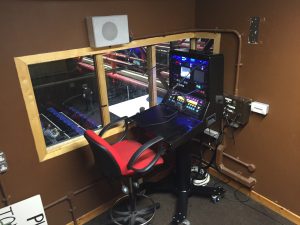
My Beautiful (Freshly Cleaned) DSM Booth
Due to this, I was given the chance to call the final show as well, something I wouldn’t live to regret, but would certainly challenge my ability. In our continuing style, our flooring went down, this time in our best time of six minutes, working around LX raising boom poles and fellow Stage crew assembling a seating bank out of our steel deck and pucks from previous performances. The directors wanted to create a projection screen out of wadding, which we cable tied to conduit and flew on hemp from the upstage right corner, creating a snow drift effect which was quite beautiful when lit from the right angle. Though not our most impressive rig, it was certainly the cleanest and quickest to go up, which I thought was a nice way to end our CPP experience.
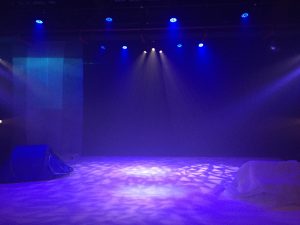 DSMing in a Winter Wonderland
DSMing in a Winter Wonderland
Clean and quick could in no way be used to describe the tech process, however, as directors clashing on ideas and not understanding the process of how a tech session works, combined with actors who didn’t appear like they wanted to be in the space, left me with what was quite a complex show in a book that was rewritten three times before we had the chance to run it. Combined with overlapping sound cues, AV cues, and performers unwilling to take cues from anything except cue lights, this really tested my ability to work under time pressured circumstances, pushing me to focus and drown out everything except the improvised text and the book in front of me. And yet, we did it. The shows ended up remarkably clean and both performers and directors were happy with what we’d all managed to achieve. Five hours later the venue was pristine again, the catwalks hoovered, the floor painted, and everything back where it should be. CPP had left the Chandler better than it had found it – something I can relate to as well.
That One Time The Chandler Was Clean
So why was this the best allocation I could have hoped to end first year with? Because, in short, it made me believe that I could keep up with this course. These shows tested my ability to work in conditions I wasn’t comfortable with, and come out stronger because of it. They pushed me to think for myself, to take control of a team, and to have faith in my own ability. They have allowed me to expand my learning in so many different ways and have given me the opportunity to fail and learn from those failures whilst still pulling off great work at the end. Taking this forward into next year, I would hope to give others the ability to experience what I have here, whilst giving them all the support they may need so that they never feel under the same strain and pressure that I did. I understand that asking for help doesn’t mean that you are inherently weak, so I would like to create an environment where questions are seen as opportunities for learning rather than as a threat to my way of doing things. In management roles, I have learned that support is vital, yet sometimes trusting the ability of others can give them such pride in the work they do that freedom is vital too.
SaveSave


